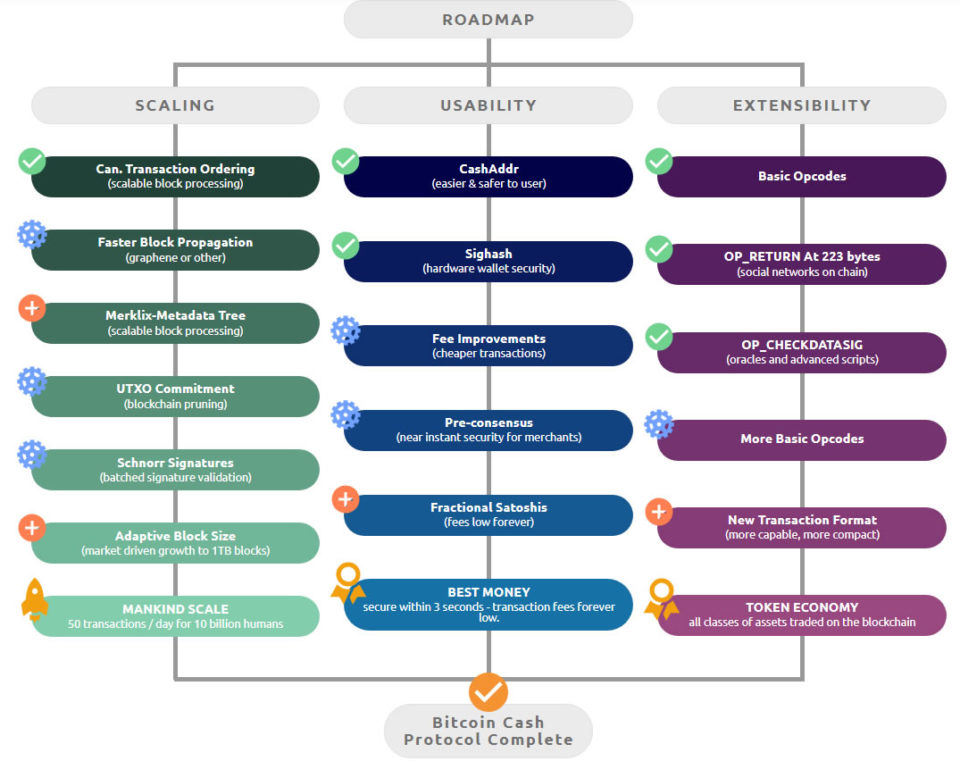The Three Pillars of The Bitcoin Cash Roadmap
Posted on Categories Crypto News

Cryptocurrencies, like any technology based projects, are constantly evolving and upgrading. Whether it is to keep up with their competitors, enhance security and performance or increase their user base, crypto projects need to advance. And in this regard, a roadmap is the pathway to the expected evolution. This article will focus on the three pillars of the Bitcoin Cash roadmap, and its key stages for the development of the project.
Bitcoin Cash (ABC) was spawned in mid-2017 when a group of developers wanted to increase Bitcoin’s block size in order to improve its chances at becoming a transactional currency, as opposed to a store of value. Since the hard fork in August of the same year, the team has continually strived to improve BCH. The corresponding roadmap highlights what is in store for the future of the world’s fourth largest cryptocurrency. There are three pillars of the Bitcoin Cash roadmap, and its contents state:
“This roadmap is intended to provide high-level technical direction, and enable different technical teams to work together towards a common goal for advancing Bitcoin Cash. The role of developers in furthering this goal is to produce high-quality professional software that serves the needs of its users, miners and merchants.”
The three pillars of the Bitcoin Cash roadmap
The improvements in the roadmap have been broken down into three categories based upon scaling, usability and extensibility. According to bitinfocharts.com there are currently 25 BCH transactions per minute. However, the network can currently handle just over a hundred transactions per second. Nonetheless, the team has lofty ambitions of over 5 million Tx/s which dwarfs even Visa.
Instant and secure payments are also high on the list and a target of transaction security within three seconds has been set. An extensible protocol to make future improvements less disruptive is the third pillar of the road map.
A number of developments on the scaling side are already underway such as faster block propagation, UTXO commitment and Schnorr signatures. The signature improvement will replace the single sig per transaction method currently used, thus improving scalability. In a nutshell, a single signature will be used for multiple transactions, and this will decrease the block size occupied by one transaction. According to the official website, Schnorr signatures will be part of the May 15 protocol update.
Bitcoin ABC 0.19.3 is now released! The Bitcoin Cash protocol is upgrading on May 15th. Prepare today: https://t.co/UbokNjiT97
This release includes more RPC improvements. Check it out! #bitcoincash #bch #bitcoin
— Bitcoin ABC (@Bitcoin_ABC) April 10, 2019
Over the past couple of months, BCH developers have also been working on a pre-consensus method called Avalanche. In technical terms ,Avalanche is a proof-of-concept consensus algorithm adding Byzantine fault tolerant proofs to the blockchain network, so nodes can differentiate between two conflicting transactions. The system is still experimental at the moment but it is another step on the improvement roadmap for the BCH team. Early testing in February indicated that Avalanche could be up to ten times faster than Ethereum.
The pre-consensus developments come under the usability category for BCH improvements. It would vastly advance security for merchants providing almost instant secure verifications. Sighash and CashAddr, new Bitcoin Cash address formats, have already been implemented to the network.
Fee improvements and cheaper transactions are a goal for any crypto project if it is to become a dominant form of digital cash. Currently, the average transaction fee is 0.000015 BCH (or $0.0045 USD), so it is already way ahead of rival Bitcoin which is $0.68 on average at the moment.
To keep fees low, the BCH team has proposed fractional Satoshis further down the roadmap. This would benefit users in the form of virtually free transactions if the price of crypto assets skyrocketed again. Joannes Vermorel pointed this out in a blog post during the crypto peak in 2017;
“Bitcoin Cash needs to be designed in such a fashion that it is possible for mankind to spend less than 0.001% of its whole monetary supply per year in order to transact freely. Over the lifetime of a human, 100 years, the total transaction fees would remain below 0.1% her or his average monetary capital, which feels about right.”
Several extensibility improvements have already been made, but more Opcodes are in the pipeline with the ultimate goal of a new transactional format and a complete token economy in the future.
The recent squabbles involving the Bitcoin SV chain and its proponents have the negative effect of distraction from the real issues of building a working and usable decentralized crypto currency. The Bitcoin Cash ABC team is still highly focused on this task on taking the digital currency to the next level.
Read more:
- On reducing the Bitcoin block size to 300kb
- More drama with Roger Ver/Jimmy Song $1 million bet
- The Flappening: Litecoin overtakes Bitcoin Cash
The post The Three Pillars of The Bitcoin Cash Roadmap appeared first on Crypto Insider.